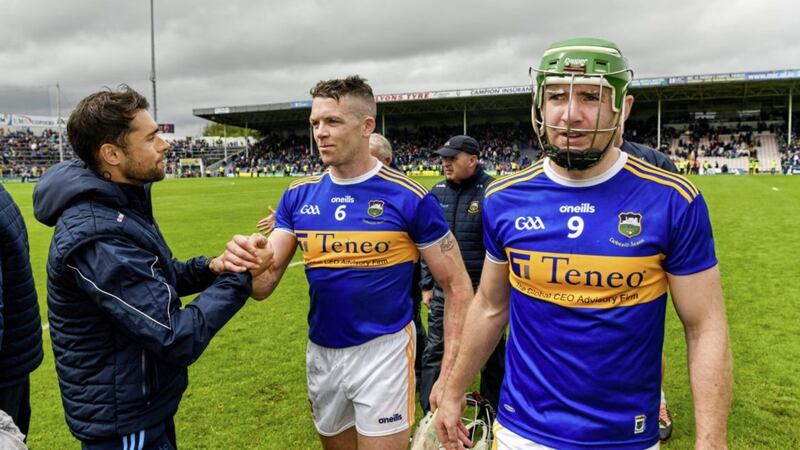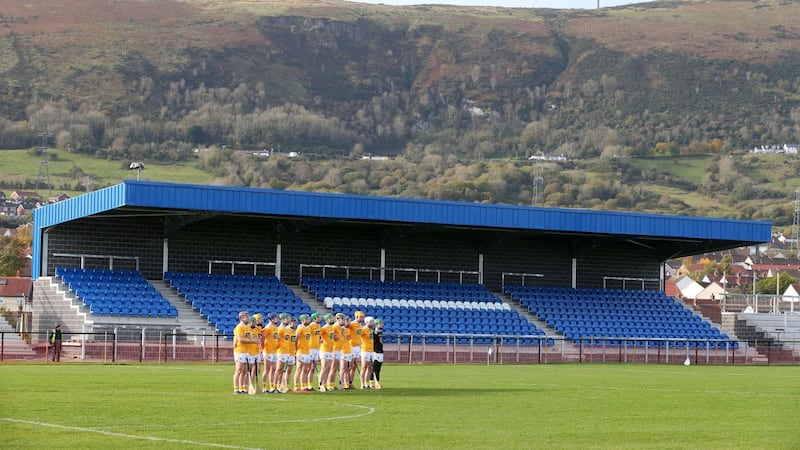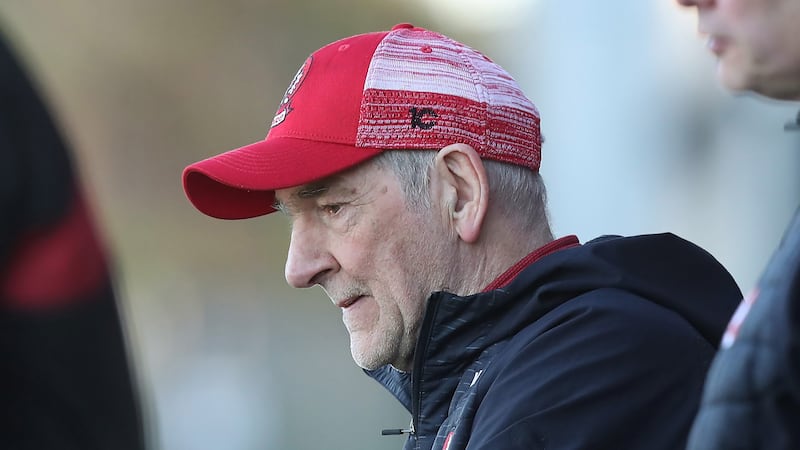“We had Diarmaid Carr there to back up an absolute legend in Cairbre Ó Cairealláin. He put some serious work into us.”
Tipperary captain Séamus Callanan during his victory speech
* * * * * * * * * *
THE morning before the All-Ireland hurling final, Cairbre Ó Cairealláin took a trip to the foot of the Galtee mountains.
That was where his mother was born. Her father, his grandfather, was Flann Ó Riain, a lifelong Irish language activist and author who wrote an Irish Times column and once spent a short period in jail after refusing to pay his TV licence in protest at RTÉ’s neglect of the Irish language.
This, or Kilmacleague in Cork where his grandmother hailed from, was the scene of Cairbre’s young summers. But it had been a while.
After much searching, he found an elderly man and enquired if he knew where Flann Ó Riain had lived.
“He knew him well. He started telling me stories,” his grandson smiles.
He didn’t go in, but came away happy that whoever lives there now still had the blue and gold flag fluttering out the front.
The nationalism courses through Ó Cairealláin from every direction. His mother, Aoife, came to Belfast with his father, Gearóid, who was another Gaeilgeoir. They settled in his jurisdiction on the Andersonstown Road, in the shadows of Casement Park, in the early 1980s.
An interest in the language naturally fused into a love for the GAA, and their three boys were hurling on the brain, doing their early pucking at St Paul’s.
So when Cairbre climbed the Hogan Stand steps and lifted Liam MacCarthy in front of the throngs of Tipperary supporters late on Sunday afternoon, it meant everything to him.
His place in the shadows was far from insignificant, but well shielded from the light enjoyed by the Callanans and Mahers and McGraths of the piece.
Not that the credit game is for him. It’s more about the deep sense of satisfaction that he was able to bring to Borrisoleigh yesterday, where the players and management finally got some time to celebrate their success alone.
To some observers, the role of the strength and conditioning coach in GAA setups can be oversold. But in hurling terms, that can no longer be.
Galway came along with their beasts of men that ruled the skies in 2017. Limerick matched them for muscle but beat them for lung capacity last year. Tipperary took that as the template.
Ó Cairealláin had studied in Limerick, where he forged his fledgling reputation. Working under Brian Lohan with Patrickswell for a season, he ended up starting in with Limerick minor footballers before progressing eventually to their hurling academy under Anthony Daly.
While Lukasz Kirszenstein rightly took so much credit for both Galway and Limerick’s successes of the two years previous, Ó Cairealláin had no slight hand in the formative years of the Treatymen who’d largely take in All-Ireland minor and U21 finals en route to their senior success.
Then a chance came to go to Arsenal, where he worked in the youth academy and then with the women’s team. The lifestyle in London got to him though and after three years, he decided to return home to Belfast last summer.
As a player, Ó Cairealláin enjoyed the relative high of being part of an Antrim side that pushed Limerick to a point in an All-Ireland quarter-final at minor, and the low of a rare Ulster defeat at U21 when Derry got the better of them.
Having transferred to Na Piarsaigh in Cork when he began studying in Limerick, a broken foot in a trial game for Antrim’s senior squad was followed by a hip injury. By the time he was fit again, he was bound for London to start a job that rendered his playing days effectively over.
But in coming back home, his timing couldn’t have been better.
* * * * * * * * * *
LIAM Sheedy got a hold of his number and by the end of the first meeting in the Abbey Court Hotel in Nenagh, he was sold.
“We had a couple of meetings and once you sit in front of Liam, you quickly get a sense of the drive behind the man and the leadership.
“It comes across very quickly, the same feeling the players get leaving the changing room after he’s been talking to them.
“I’m used to working a few years in Arsenal, you go into work in a normal job as such. You come here and into training at 5.30, everyone else has been to work already and they’re coming to training with this energy that this is their release, essentially.
“Liam would be to the forefront of that, he’d be the happiest man in the changing room every night and you could see how much he loved being there.
“That was absolutely infectious, the players and backroom team would feed off that. He’d always say it’s not hard to enjoy yourself when you’re laughing, so he’d bring that element of light-heartedness to it.
“At the same time, you’d never want to cross him because he has incredibly high standards. He applies them to himself and he expects everyone in the team to live and work by those same standards.”
Sheedy had in his mind that in order to bring Tipperary back to the top, there was huge work to be done on the physical end of things.
Working in tandem with nutritionist Gary Sweeney, they set about changing the body compositions of the Tipperary players.
“It wasn’t necessarily to have big players, but to better somebody’s body composition in terms of their ratio of lean mass, or muscle mass, to fat, the better they’re going to move on the pitch.
“That was the key, we were looking for the players to be lean but have strength. There was a big emphasis on strength training.
“We’d have co-ordinated sessions that boys could train in a regional centre under a coach we’d brought in. That meant boys could spend more time training instead of travelling back to Tipp for gym sessions.”
While so much of the sport’s gladiatorial instinct is unscathed, hurling has changed. Ó Cairealláin points to their All-Ireland semi-final opponents, Wexford, as the prime example of what is required of players.
“Definitely the game is going in a certain direction where the physical component is massive, more so than before, and it’s going to continue to be that way.
“You can see the way Wexford play, their game depends on the players being incredibly well conditioned.
“When Tipp were reviewing last year and where things mightn’t have gone as they’d have hoped, Liam’s earmarked the physical side of things as being very important to getting them to where they needed to be.
“From early on, that was one of the priorities and the players were incredibly driven to make up for the last couple of years. They put in an unbelievable effort to get into the best shape they could.”
Once they had a baseline to work from after November testing, they went hard at it.
The work they were doing quickly became evident. After their opening Munster SHC win over Cork, Lar Corbett remarked upon the physical make-up of their defence in particular.
“The S&C work is so obvious to the extent that you had three Mahers in the half-back line last Sunday and it was hard to tell them apart.
“Usually, you’d be able to tell Paudie a mile off because of his physique but the work that Brendan has put in recovering from a cruciate has left him in great shape and at times it was hard to tell him from Paudie or his brother, Ronan.”
They put on a huge training load early in the year, and for Ó Cairealláin the whole thing depended on the Tipperary players buying into their recovery properly.
“You can only train at the level of intensity we’re looking if the players were recovering between sessions, and the players had emphasised that more than in the past, and that allowed us to accelerate their progress because their recovery between sessions was so good.”
They could only play as hard as they trained, and it was in the younger fringe members of the panel putting on a fair bit of muscle mass throughout the year that Liam Sheedy was able to drive the standard within sessions.
That helped them bridge another gap to Limerick, whose incredible depth off the bench last year marked them as a possible dominant force. They got 0-5 off their subs on Sunday, with the likes of Jake Morris making big strides to step straight in from U20s and play such a big role in their semi-final comeback against Wexford.
It helped that Ó Cairealláin’s just 31 himself. That allowed him to relate to the players and fit into the social circle. “An absolute legend” was how Séamus Callanan described a man that the players see as a friend.
He sees himself as a small part of a huge support structure that the players have had around them this year.
But he’s a hurling man too. And that’s what made the thrill of it so great.
“Hurling was everything to us growing up, we lived and breathed it.
“There was that moment when you’re walking up thinking ‘I’m actually going to lift the Liam MacCarthy Cup’. It’s something you’d always thrown around since you were a kid, that you would get to do that some day.
“It was nice.”
His own celebrations were relatively sensible. Doesn’t drink much, and didn’t really bother Sunday or Monday. But as he hangs up the phone, he’s off to find out where the players are meeting at and fulfil the promise to have a couple on the Tuesday if they’d won.
“I’ve been telling the players all year if we did this All-Ireland, I’d break out and have a beer. So they’ll be expecting me to salute them with one drink anyway.”
In a game that has morphed into a survival of the fittest, Cairbre Ó Cairealláin is a serious asset to Tipperary.








